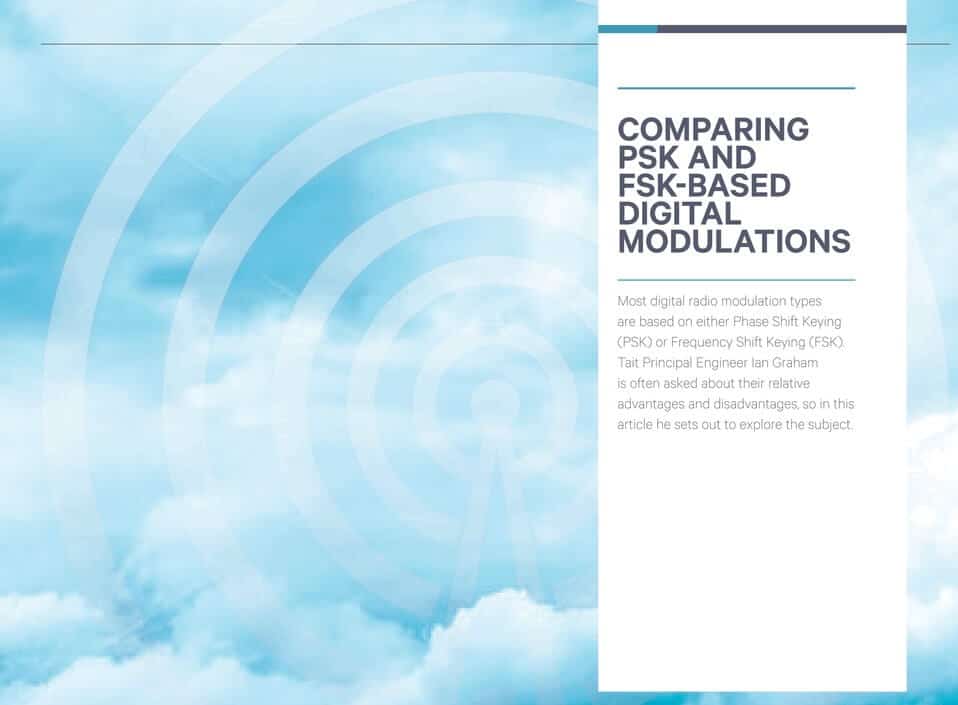 Most digital radio modulation types are based on either Phase Shift Keying (PSK) or Frequency Shift Keying (FSK). Tait Principal Engineer Ian Graham is often asked about their relative advantages and disadvantages, so in this article he sets out to explore the subject.
Most digital radio modulation types are based on either Phase Shift Keying (PSK) or Frequency Shift Keying (FSK). Tait Principal Engineer Ian Graham is often asked about their relative advantages and disadvantages, so in this article he sets out to explore the subject.
To make it ‘real’, we will compare two actual modulation schemes: Linear Simulcast Modulation (LSM) – a type of PSK, and Continuous Four Frequency Modulation (C4FM) – a type of FSK. We will describe them, cover their relative advantages and disadvantages, then use an example simulcast system to show a practical comparison.
What is LSM?
LSM is a type of differential QPSK, meaning the symbols are separated by differences in phase between one symbol and the next. There are four symbols (+3, +1, -1, and -3) so each symbol conveys two bits of data. Symbol rate is 4800 symbols/sec, giving a data rate of 9600bits/sec. Transitions between consecutive symbols involve changes in amplitude and phase, so the resulting signal is non-constant amplitude.
The LSM diagrams on the right show IQ, eye diagrams and spectrum before and after filtering. At the output of the IQ modulator (before filtering) the transitions between symbols appear as straight lines and the eye is 100% open, but spectrally, there would be many sidebands. The signal cannot be transmitted in this form, so filtering of the I and Q outputs is necessary to remove unwanted spectral content. After filtering, the transitions now appear curved and the ‘eye’ has closed slightly, to about 80% open. Spectrally, we have a much cleaner signal that can now be transmitted.
What is C4FM?
Continuous Four Frequency Modulation (C4FM) is a type of FSK, so symbols are separated in frequency. The four symbols (again named +3, +1, -1, and -3) each conveys two bits of data. Symbol rate is 4800 symbols/sec, giving a data rate of 9600bits/sec. Transitions between symbols involve changes in frequency, so the resulting signal is constant amplitude.
The C4FM eye diagram shows that after filtering, the ‘eye’ is only around 40% open, and spectrally, the signal is much less ‘clean’ than LSM.
Comparing LSM and C4FM
In general, for a given symbol rate, LSM is spectrally cleaner (less spectrum overflowing in to neighboring channels), but requires linearized transmitters because the transition between symbols involves both the amplitude and phase of the signal changing.
For the same symbol rate, C4FM is less ‘clean’ and produces more energy in adjacent channels. However, because the transition between symbols involves only a frequency shift (amplitude stays constant), a simple, non-linear FM transmitter can be successful. So PSK-based modulations can achieve a greater data rate (bit per second) inside a given channel bandwidth. Consequently, P25 Phase 2’s HDQPSK (Harmonized Differential Quadrature Phase Shift Keying) modulation on the downlink achieves 6000 symbols/sec inside a 12.5kHz channel, while P25 Phase 1’s C4FM modulation only achieves 4800 symbols/sec in the same bandwidth.
Another trade-off is transmitter efficiency. As C4FM is constant amplitude, a standard class AB (nonlinear) transmitter can provide efficiency around 65%. On the other hand, for LSM (where the signal also contains amplitude content), a linearized transmitter is necessary.
There are many linear PA architectures, with widely varying efficiencies. For example, a feed-forward linear PA might only have 20% efficiency as the architecture involves two power amplifiers. A Cartesian Loop linear PA might have around 60% efficiency, but that’s just the PA. The entire architecture involves additional signal processing that consumes current too.
In the next part, we will compare delay spread tolerance and costs for LSM and C4FM networks.
 This article is taken from Connection Magazine, Issue 5. Connection is a collection of educational and thought-leading articles focusing on critical communications, wireless and radio technology.
This article is taken from Connection Magazine, Issue 5. Connection is a collection of educational and thought-leading articles focusing on critical communications, wireless and radio technology.
Share your views, comments and suggestions in the Tait Connection Magazine LinkedIn group.



